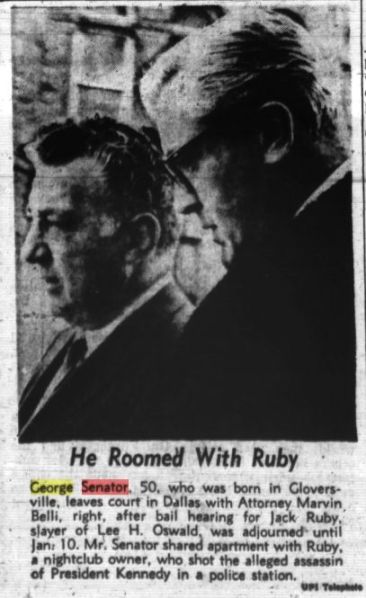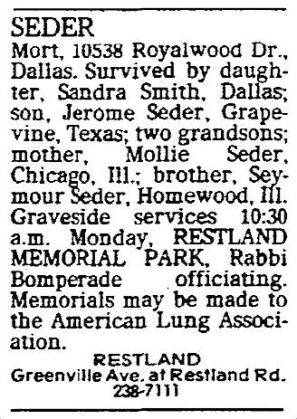Author’s Note: Rather than sharing a list of sources at the end of posts as I’ve done in the past, I am now linking directly to them throughout the article as I reference the information gleaned from them. Clicking the link will take you to the source by opening a new window, so you won’t lose your place as you read.
Newspaper readers who opened their Thursday, December 26, 1963 edition of the Leader-Herald would have found this article on page 3: “FORMER RESIDENT OF CITY TESTIFIES AT RUBY BAIL HEARING IN DALLAS; SENATOR DESCRIBES SLAYING SUSPECT.”
If you know your American history, or are of a certain age, you probably already know that “Ruby” is Jack Ruby, and the “slaying” is the shooting of Lee Harvey Oswald, the man believed to have assassinated John F. Kennedy on November 22, 1963, in Dallas, TX. Jack Ruby fatally shot Oswald on live television two days later, as the assassin was being transferred to county jail.
At the time, Ruby had been sharing an apartment with George Senator, a Gloversville native.
“He was in Florida selling ladies’ clothes,” Jacob Senator answered when asked about the last time he heard from his brother, George. Long-time residents of Gloversville will probably recognize the Senator name: Jacob owned Senator’s Restaurant located on Church Street until 1968, when it was closed due to Jacob’s declining health (he died the following year, aged 68, at Nathan Littauer Hospital). The Senators came to Gloversville from Warsaw about 1909. The city had a large population of other Warsaw immigrants through the early 20th century, including Samuel Goldfish, but you probably know him better as Samuel Goldwyn – yes, that Goldwyn of Hollywood fame. Senator’s Restaurant opened in 1931/32 at 56 North Main Street and moved to the location at 8 Church Street in 1949. A grand opening celebration was held for the “New” Senator’s Restaurant that February; the Morning Herald featured almost an entire page of congratulatory ads taken out by other local businesses.

In this slightly blurry photo, you can spot the Senator’s sign on the left near the corner, above the “One Way” sign. (Photo from Lewis G. Decker’s Gloversville book in the Images of America Series.)
If Jacob’s life was reflected by his success as a long-time business owner and well-known member of the community, his brother George moved around frequently and worked a number of different jobs. He didn’t keep in touch very well with his family in Fulton County. At the time of the 1963 article referenced above, George had been living in Dallas already for nine years, while his brother thought he was still in Florida. Jacob confirmed they hadn’t seen one another or spoken in about 13-14 years. The last time was a visit George made to Gloversville in 1950. Jacob heard about George’s involvement in the Ruby case from someone else, as it was reported in newspapers in New York City and Albany, but he had not read either article.
So if George Senator had not been in touch with his Gloversville kin for well over a decade – a fact he also confirms in his testimony – then why was there a 14-minute phone call to Gloversville made from Ruby’s Ewing Street apartment on July 21, 1963?

This is a question that has intrigued me ever since I came across the phone records from Ruby’s apartment – and in fact, I included a vignette on this topic in my “Short Stories of Fulton County” post from April 2017. I don’t remember how I ended up looking at these records in the first place – but the Gloversville connection to the JFK assassination has always interested me, and I’ve wanted to dig deeper into it. So, it was probably one of these bouts of obsessive research that I stumbled upon it. Every so often, I’ll go back to this piece of information and really fall down the rabbit hole trying to figure out that essential question: why?
Thankfully, those phone records included the phone number dialed, so using Tom T.’s

From the Albany Times-Union, December 27, 1963.
wonderful resource, FultonHistory.com, I was able to get a few hits on the number in local papers. It belonged to Lewis Brott, an interior decorator, and his daughter Audrey, who managed the S&H Stamp Redemption Center in Gloversville. But that still didn’t answer my question: why would Ruby or Senator be calling Lewis or Audrey? And if it was Senator, why would he lie about his contact with anyone from his hometown?
With all of the conspiracies surrounding Kennedy’s slaying, all of the theories about who was really behind it, it became difficult not to let the imagination run wild. I had to remind myself to remain objective, to not look for “evidence” that would fit my own conjecture and support a false “truth.”
This became even more of a challenge after I found a November 20, 2013 newspaper article by Russ Tarby in the Syracuse New Times, claiming that the FBI had traced the phone call to the Gloversville summer home of Joe “The Wop” Cataldo, a Genovese capo. There are no historical records that I can find that support a Gloversville residence of Cataldo, summer or otherwise – though not out of the realm of possibility with Saratoga being so close – but still, nothing to substantiate it. The article lists the phone call as happening on July 7th, and according to the records, there was only one call to Gloversville, on the 21st. There are no accompanying sources in the New Times piece for the July 7th phone call claim, and I have yet to uncover anything that supports the idea that Ruby was calling Cataldo in Gloversville in the summer of 1963. (For an interesting read on phone calls from Ruby to mobsters that did happen, check out this blog post from The National Museum of Organized Crime and Law Enforcement in Las Vegas, better known by a much more exciting-sounding name: The Mob Museum.)

[George Senator, Jack Ruby’s roommate], photograph, November 24, 1963; (texashistory.unt.edu/ark:/67531/metapth185106/m1/1/: accessed December 5, 2018), University of North Texas Libraries, The Portal to Texas History, texashistory.unt.edu; crediting The Sixth Floor Museum at Dealey Plaza.
The surname rang a bell first, when I had been looking for information on Audrey. My search on Ancestry revealed that she had been married more than once, and so her last name changed over the years. On March 9, 1963, Mort Seder and Audrey Brott Brown were married, and remained so for the next three years.
Mort Seder and George Senator had known each other for thirty years at the time of Kennedy’s assassination. Senator’s Restaurant’s original location at 56 N. Main was just down the street from Seder’s Apparel Shop, Mort’s father’s business, at 36 N. Main. From 1954-58, Senator and Seder lived as roommates in various apartments in Dallas. Up through the JFK assassination, Senator worked for the Texas Postcard and Novelty Company, owned by Seder and Ernest St. Charles. This was a side business for both men: Seder was a traveling salesman of men’s apparel and St. Charles operated a drug store.
Despite the solid connection between the two men, the Gloversville phone call from Ruby’s apartment still baffled me. I finally reached out to the Dallas Historical Society, originally in search of an obituary for Seder in an attempt to find out more information about him and his life before and after 1963. Their Research and Archives Department put me in touch with Paula Bosse, a researcher who runs a wonderful blog called Flashback Dallas. Not only did Paula answer my inquiry about an obituary for Mort Seder by passing along the funeral announcement, but she also sent me a ton of incredible links to digitized records from the FBI’s investigation into George Senator and, in connection, Mort Seder.

Mort Seder funeral announcement, The Dallas Morning News, June 23, 1980, courtesy of Paula Bosse.
It turns out that Seder was the one who made the call to Gloversville on July 21, 1963. He was visiting his old friend Senator in apartment 207 at 223 S. Ewing St., Dallas. Seder wanted to call home to his wife, and since Senator lacked a telephone, the pair went next door to apartment 206: Jack Ruby’s. There, Seder called Audrey in Gloversville and they spoke for about 14 minutes. Seder said he only knew Ruby through Senator and had seen him only a few times.
So, there was my answer. No crazy conclusion that connected Ruby to mobsters hiding out in Gloversville summer homes. No new information about a Ruby connection to Fulton County. It seemed almost too simple – so much so that I wondered why it had taken me so long to make the connection. I am thankful for having been put in touch with Paula, however, as she sent along some amazing links, including a link to her post about recently discovered film footage of Jack Ruby in 1960, which features – as she and others believe – George Senator standing next to him. At first I wasn’t sure it was Senator, but then again I have only seen photos from 1963-64. After watching the slowed down version a couple of times, I’m starting to think it is, indeed, Senator. What do you think?
Great post! Thanks for the nice words!
LikeLike
Thank you! And thank you for reading!
LikeLike
Your posts are always so informative and so interesting!
LikeLiked by 1 person
I will never forget the FBI coming to our home at 34 Prospect Ave and questioning my Mom, Audrey and my stepfather Mort. It was quite exciting.
LikeLiked by 1 person
Stacey, thank you for commenting! I would love to hear more if you’re interested in chatting with me. My email is historian@fultoncountyny.gov. The Gloversville connection to Jack Ruby has always fascinated me. It must have been quite something to have the FBI at your house!
LikeLike
I live there right now that’s so cool
LikeLike
lol….mort seder was my grandfather.
he is buried next to my mother
LikeLike
I am one of the 2 grandsons in the obituary.mort seder,’big daddy’ to us-was my grandfather.
I just happened to stumble over this article-and I’m so very greatful.
thank you.
LikeLike